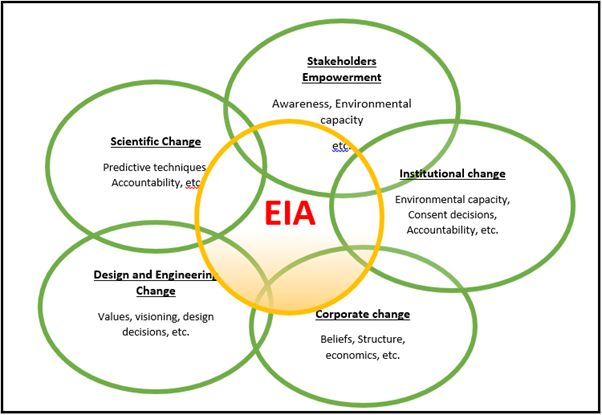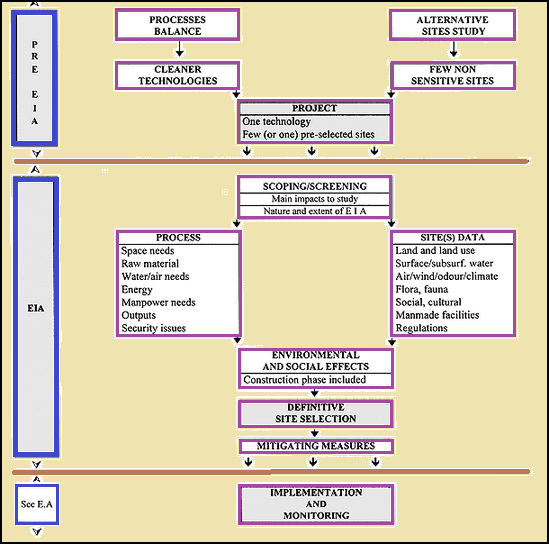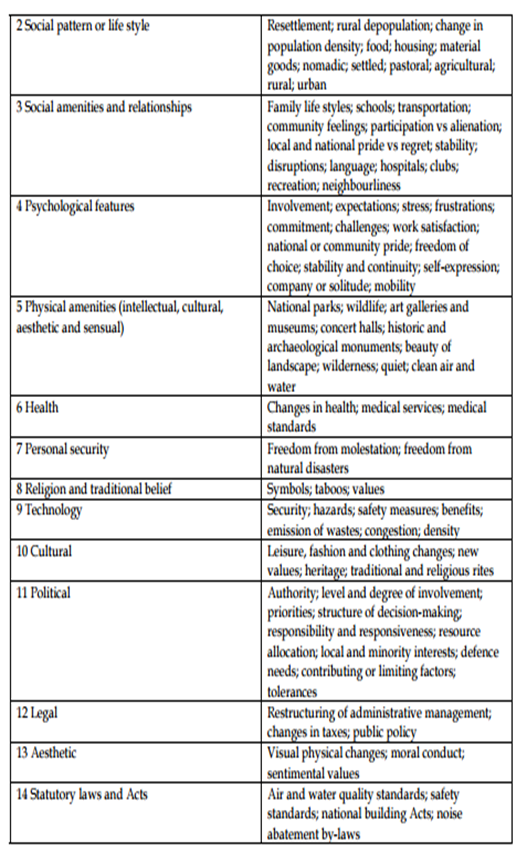Environmental Impact Assessment
Environmental Impact Assessment, abbreviated as EIA is comparatively new planning and decision making device first used in the United States in the National Environmental Policy Act of 1969 that raised awareness of the serious environmental effects of human activities which were inadequately controlled by existing planning regulation and pollution control measures. The spread of EIA to other countries gained impetus due to four fundamental factors that include an increasing awareness among the general public of the danger and impacts of major development and new technologies due to a better scientific knowledge and publicity. Secondly, the increasing activities of environmental pressure groups. The third, was the widespread concern about the sheer scale of resource developments and their associated environmental effects. Fourth, all of the above reasons made the western developed nations more cautious and responsive to environmental concerns. Environmental impact assessments commenced in the decade of 1960s, as part of increasing environmental consciousness.
In theoretical literature, term, Environmental Impact Assessment is described as the process of identifying, predicting, evaluating and mitigating the biophysical, social, and other relevant effects of development proposals prior to major decisions being taken and commitments made. It is a formal study procedure used to foresee the environmental consequences of any development project. It is a system which assist researcher understand the potential environmental impacts of major development proposals. EIA establishes a systematic method for incorporating environmental considerations into decision-making. Based on Environmental Assessment, the supervisory measures can be recognised and the roles of concerned agencies defined for realising more effective environmental management. Major function of Environmental Impact Assessment are to predict problem to find ways to avoid them, and to enhance positive effects. Assessors stated that Environmental Impact Assessment is required for all projects that have been identified as likely to have a significant effect upon the environment (Shrivastava, 2003).
Objectives of Environmental Impact Assessment
- To make sure that environmental considerations are explicitly addressed and incorporated into the development decision making process.
- To forestall and avoid, reduce or offset the adverse significant biophysical, social and other relevant effects of development proposals.
- To shield the productivity and capacity of natural systems and the ecological processes which maintain their functions.
- To encourage development that is sustainable and optimizes resource use and management opportunities.
It has been revealed in studies that Environmental Impact Assessment is intended to protect the environment by ensuring that a local planning authority when deciding whether to grant planning permission for a project, which is likely to have significant effects on the environment, does so in the full knowledge of the likely significant effects, and takes this into account in the decision making process. The regulations set out a process to recognize those projects which should be subject to an Environmental Impact Assessment, and for assessing, consulting and coming to a decision on those projects which are likely to have substantial environmental effects. The purpose of Environmental Impact Assessment is also to make certain that the public are given early and effective opportunities to contribute in the decision making procedures (Shrivastava, 2003).
Common components of Environmental Impact Assessment in different countries:
- Screening: Is an EIA required; what level of detail is required.
- Scoping: The issues and impacts of the project; who are the stakeholders; what is the current state of the environment.
- Identification of alternatives: What alternatives exist?
- Impact analysis: What are the environmental, social and other related impacts of the project?
- Mitigation and impact management: How will the impacts be mitigated, reduced or managed.
- Evaluation of significance are the impacts acceptable.
- Preparation of an Environmental Impact Statement or report: Documentation of the proposal, impacts, impact mitigation and management options, level of significance and concerns.
- Review of Environmental Impact Statement: EIS is open for public comment for a sufficient period of time.
- Decision making: Public comments considered and a decision made whether to accept the proposal as is, modify the proposal or reject the proposal outright.
- Monitoring and review: Develop an implementation plan; begin monitoring and review of the project.
Features of Environmental Impact Assessment
There are several characteristics of environmental impact assessment:- It is a methodical evaluation of all noteworthy environmental consequences.
- It is a structured, systematic and comprehensive approach.
- It is a procedure which forces developers to reassess proposals.
- It is a process leading to a statement to guide decision-makers.
- It is a method which has the potential to increase developer's responsibility to the public.
- It should be subject to independent, objective review of results.
- It should include clear statement of identified impacts as well as possible alternative development options.
- It is an extrapolative tool and estimates the changes in the quality of the current environment as a result of the proposed action.
The structure of an Environmental Impact Assessment differs according to the project, location and the authorship. Environmental Impact Assessment, which deals only with project impacts, includes a current environmental conditions and accounts of project impact as well as available alternatives to the anticipated project.
EIAs has immense role in sustainability. According to Cashmore et al. (2004), "EIAs are a decision tool employed to identify and evaluate the probable environmental consequences of certain proposed development actions in order to facilitate informed decision-making and sound environmental management". It studies both environmental and economic costs and benefits. Cashmore et al. (2004 Pp: 306) provide a schematic representation of the relationship between the conception of EIA to sustainable development goals and society.
Environmental Impact Assessment as an agent of incremental change

To construct Environmental Impact Assessment, following sections must be considered by developer:
- Preliminary activities: Preliminary activities encompasses the defining of the Terms of Reference for the project and also the determining of the personnel required for the assessment. A brief summary of the project is very helpful at this stage.
- Scoping: Scoping is a process to identify environmental impacts of the project. At an early stage in the preparation of an Environmental Impact Assessment, the impacts of the project on the environment are identified. This process, therefore, determines the limits and the scope of the environmental degradation involved with the project. Scoping controls the cost and time of the assessment in deciding the scope of the EIA and therefore is a very important step both in identifying the impacts and controlling the size of the Environmental Impact Assessment.
- Baseline study: A baseline study is the study of the original status of the environment in the area before the development work of the project is started. This study serves the purpose of a base reference against which the changes due to execution of the project are measured. Baseline studies are based on the experience with respect to environmental aspects and cover everything important about the environmental impacts of the project.
- Environmental impact evaluation: This evaluation develop from scoping and baseline study of the project. In principle, Environmental Impact Assessment assigns various quantified values to different levels of all the impacts affecting the project.
- Mitigation measures: These measures are taken after the impact evaluation. These measures lessen the magnitude of the impacts affecting the environment.
- Assessment of alternative measures: The planned project and all other pertinent versions have been scrutinised for environmental impacts by now. They have also been corrected by applying the mitigation measures to minimize the adverse effects on the environment.
- Preparation of final document: This document should meet the objectives such as preparing a complete and detailed account of the Environmental Impact Assessment and formulating a brief summarized account for decision maker who may not be technical expert. The detailed document is usually called as the reference document. This document is used by the technical employees that is associated with the project. It is also referred for formulating future EIAs in the same terrestrial area, or for the same type of project in a different area. The referred part usually contains the technical calculations, graphs, and the results of field and laboratory measurements. The summarized non-technical account is commonly known as the working document, which is written clearly without using technical language to converse to the decision-maker the findings of the EIA team. Major intent of this document is that the non-technical decision-makers must appropriately understand the findings and recommendations of the EIA team so that they can take wise decision quickly.
- Decision-making: This process begin after completing all above steps. Normally, the decision is taken by a manager or a committee, or personnel from the concerned ministry who had not been associated with the EIA during its preparation. Generally, a decision-maker has three choices:
- Accepting one of the project alternatives.
- Returning the EIA with a request for further study in certain specific areas.
- Totally rejecting the proposed project along with alternative versions.
- Monitoring of project implementation and impacts: This is done while the selected project is under actual execution. The monitoring is fundamentally the procedure of examination to make sure that the proper guidelines and recommendations stated in the EIA are devotedly followed.
Environmental Impact Assessment cycle (Source: Breche)

Techniques used to identify environmental impacts
- Checklists: A common, simple and low-cost method is the checklist. These can be categorized into different types. Simple checklists list the components or aspects, usually of the environment that might be considered by the assessor but no other assistance is provided to guide the impact identification process. Descriptive checklists offer additional assistance by indicating, for example, the specific variables to be measured to characterise each component. Scaling checklists go a step further and include simple devices for assessing importance of suspected impacts. This can be done through the use of letter or numeric scales assigned after comparison with criteria supplied in the checklist, to indicate the importance of an impact. Another approach is to use threshold values, based on statutory criteria or on derived measures. The suspected impact can be estimated in broad terms and given a value to represent its significance. On that basis, a start can be made on comparing and ranking alternative project options. Lastly, the questionnaire checklist, is a form of scaling checklist but uses a series of carefully directed questions to elicit information about possible impacts and their likely importance. Checklists aid to organise the work and recognise important issues.
- Matrix: This is detailed procedure where project activities are cross-tabulated with environmental components. Matrices can be made quite simple or be developed into a stage with huge information. Advantage of the matrix approach is the practicality in designing further studies, the inexpensive nature and their comprehensiveness (Shahid A. Abbasi, D. S. Arya, 2000). Major drawbacks may be an inability to handle indirect impacts and temporal aspects, a potential rigidity of categories, and a difficulty to get an overview when many variable are included.
- Networks: Network diagrams may be used to illustrate linkages and higher order effects in the system. Network methods recognizes interactive nature of environmental components and take an ecological approach to identify secondary and tertiary impact (Shahid A. Abbasi, D. S. Arya, 2000).
- Overlay techniques: These techniques are sometimes referred as McHarg�s method. These methodologies are relied on set of maps of environmental characteristics such as physical, social, ecological, aesthetic for a project area. These maps are overlaid to produce a composite characterization of the regional environment. Impacts are identified by noting the impacted environmental characteristics lying within the project bindings. This is highly aggregative approach and is useful to shortlist the alternatives where decision is mainly based on physical characteristics (Sondheim, 1978).
- Ad hoc method: It provides qualitative assessment of total impact while suggesting the broad areas of possible impacts and general nature of these possible impacts (Shahid A. Abbasi, D. S. Arya, 2000).
- Delphi method: It is a method based on intuition or expert opinion, especially designed to avoid the drawbacks associated with the other methods of opinion gathering. This method has three features that include anonymity among participants, scope for statistical treatment of responses and iterative feedback (Shahid A. Abbasi, D. S. Arya, 2000).
Munn (1979) recorded 'Areas of Human Concern' or impact categories which must be included in an Environmental Impact Assessment:
Table: Impact Categories which should be included in EIA (Source: Munn, 1979)


In Indian context, clearing environmental projects through environmental impact assessments, overthrows the entire purpose of this vindicatory exercise, which is based on the norm of advancing sustainable development. The process of assessment of the environmental impacts is main component in taking decisions pertaining to environmental clearance, but the insufficiencies of the Environment Impact Assessment in India has dissatisfied the entire objective of an ecological, economic and social cost benefit analysis for sustainable development.
Many experts have criticized the practices of environmental impact assessment. One of the most common criticism is that EIA only considers the direct impact of a development or activity but not the addition to the rising impacts in the area (Simpson and Wall, 2000). EIA cannot be used for the valuation of whole tourism destinations but only for specific projects such as airports, eco-resorts, activity or development near the beach, Schianetz et al. (2007). Environmental impact assessment is also disapproved as it only deals with alleviating negative impacts instead of making effort to increase the positive impacts.
However Biswas (1992a) and Hunter (1995a) have indicated that steps of Environmental Impact Assessment have its deficiency. According to both authors, there is a trend that EIA focuses more only on physical impacts and disregard social and cultural ones. EIA frequently concentrates on biophysical matters and where environment, social and economic features are dealt with, they are not usually included but instead Environmental Impact Assessment reports have the tendency to be demonstrated as separate stages.
There is no involvement of enforcement in the process of Environmental Impact Assessment. For further movement of the process of EIA and its dimensions and decisions are based on the functions of internet. There is no emergence of decision process which is apparent with full of potential and distance collaborative and use of information technology. The major revolution has taken place because of data evaluation, modeling which is interactive, during the draft review, sharing of comments and because of the use of 3-D technology and visualization of action.
To summarize, Environmental Impact Assessment is the practice by which the predicted effects on the environment of a planned development or project are measured. If the likely effects are unacceptable, design measures or other relevant mitigation measures can be taken to reduce or avoid those effects. EIA was established to deal with concerns about the effects that main development projects were having on the environment. It is established in numerous studies that an environmental Impact Assessment supports various concepts such as Ecotourism, Cleaner Production, Eco-labelling but the two most supported concepts are Environmental Management and Tourism Carrying Capacity (Schianetz et al. 2007). The use of Environmental Impact Assessment has developed throughout the world and there are different applications exist.

